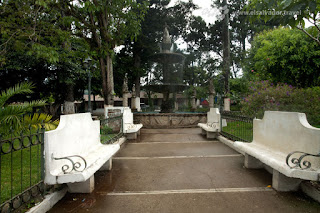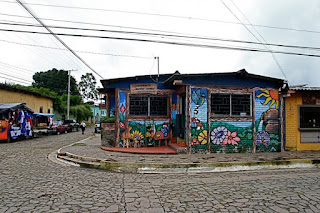Concepcion de Ataco
Ataco is a quaint, colonial village that is known for its
natural beauty, as well as, its brightly painted homes, cobblestone streets,
colorful murals and unique arts and crafts.
 |
| Ataco street view |
The municipality administration is divided into 11 cantons,
which are: El Arco, El Limo, El Naranjito, El Tronconal, La Ceiba, La Joya de
los Apante, La Planxa, San Jose, Shucutitán and Texusín Chirizo. Ataos's
population has pre-Columbian origin and was founded by Yaqui Indians or pipiles
in central Apaneca Mountain Range.
Ataco's native population still retains many of the customs and traditions of their grandparents—these go from generation to generation through oral tradition, preserving, so far, a bit of our culture and language (Nahuat).
 |
| Fountain in central park |
In the Mayan language Nahuatl, Ataco means “Place of the Elevated
Springs”. Five rivers flow through the
many surrounding mountains and from here you can see Guatemala’s southern
mountains, El Chingo Volcano, the Espino Valley, Ataco Valley and Quezalapa
Hill, among others.
In Ataco you’ll find
many little stores and workshops bursting with handmade treasures, such as embroidered
dresses, sculptures, coffee candles and hand woven textiles
History
Archbishop Pedro Cortes y Larraz, Ataco in 1770 belonged to
the parish and its people Ahuachapán was represented by 303 families with 784
indigenous people who spoke the Nahuatl of the Pipil turn these people spoke
and understood also Castilian .
 |
| Church "Inmaculada Concepcion de María", View from the central park. |
In the colonial period Ataco belonged to the administration
of the province or municipality over Izalco Sonsonate. As of June 12, 1824
belonged to the municipality of primitive and great department of Sonsonate.
Because the law of July 4, 1832 this population was made part of the
jurisdiction of the judicial district of Ahuachapán. By legislative decree of
February 8, 1855 the town was incorporated in the department of Santa Ana.
According to a municipal report dated 20 April 1858, Ataco had a population of
972 inhabitants.
 |
| Handicrafts "Madre Tierra" |
During the year 1866 the municipalities of Ataco asked the
authorities, that this population be divided and separated from the department
of Santa Ana and Sonsonate department add for convenience of local interests.
This application did not succeed.
By Legislative Decree dated 26 February 1869 Ataco joined
the district and department of Ahuachapán.
Tourism
Ataco has started its
tourism business in the late 2004. Prior to that the most visited colonial
village was Apaneca, a village 20 minutes away from Ataco. After people
realized Ataco has more opportunities and that it's a very cheerful village,
people starting investing in Ataco. Even though Ataco did not win first place
in the Pueblos Vivos contest it is still preferred by many local and
international tourists.
 |
| Tourist in Ataco |
Gourmet Food & Beverages
You
can visit the cafes to enjoy the excellent coffees from this area and visit the
restaurants where you can enjoy typical Salvadoran food and gourmet food. Ataco
has many restaurants that are national and international and they serve a
variety of foods.
 |
| "La Raclette" restaurant. |
Portland Grill and Bar, Cafe El Boton, El Habanero, El Brasero,
La Esquina de Ataco, KOI Sushi Bar, Casa Guimera , The House of Coffee, El Jardín
de Celeste, Diconte y Axul , Piccolo.
Ataco’s Looms, Diconte & Axul.
One of the most famous handicraft shops that has treadle
looms is Diconte & Axul. This is a very colorful and striking corner which
gives life to the people of Ataco, for it is out of the ordinary and
traditional. Its facade shows the lines, colors and figures of the handcrafts
that are inside. The shop's charismatic owners, Alvaro Orellana and Cristina
Pineda Fagioli, paint each piece and, as such, they should be considered
unique, a characteristics which gives them higher value.
One of the first businesses to gain recognition in the Route
of the Flowers, a variety store crafts, textile art and
has become the reference of the people to attack from more than 7 years.
Established in an old house, dating from 1910, near the center of town, Diconte
& Axul offers tourists the best opportunity to buy crafts from all over El
Salvador, and Guatemala and other countries. Here you may see the famous
"Cats" and other crafts, painted with the colorful style introduced
by the artists, Cristina Pineda Fagioli, and Alvaro Orellana, who also attend
the place. You can also see how local artisans make colorful fabrics using
treadle looms, a tradition that is disappearing throughout Latin America. In
Diconte & Axul you can purchase these unique fabrics from $6 to $8 a yard.
Ataco is waitin for you!!!


No comments:
Post a Comment